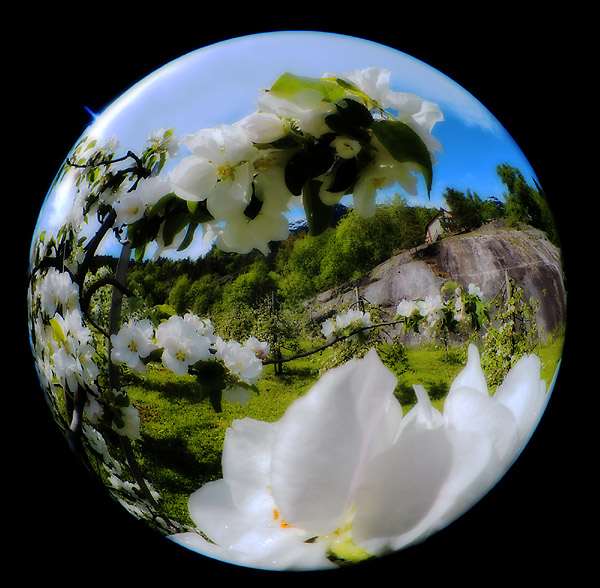Adapting circular fisheyes to Nikon D1
by Bjørn Rørslett
What do you do when you wish to use a
full-format fisheye lens on the Nikon D1, and there isn't a
mirror lock-up to allow mounting the lens, and besides, the image
circle doesn't fit the smaller frame of the D1?
This problem became evident when I planned
to press my old OP-Fisheye-Nikkor 10 mm lens into service on my
D1. I had visual applications in mind which only this odd lens
could produce. This speciality lens is a non-retrofocus design so
it extends deeply into the camera throat, ending just 10 mm in
front of the film plane. Employing a relay lens to reduce the
image circle of the fisheye lens would be the easier solution,
and additionally would help push the image plane of the 10 mm
lens further back.
The rear flange-to-film distance of a Nikon
SLR is 46.5 mm. Thus, the relay lens needs to have its infinity
focus at the equivalent position in space where the image from
the master, prime lens is formed. Because I planned on using a
combination of Nikkor lenses to give a relay system, this setup
would have an infinity focus at the desired position. The front
lens would need to be spaced 2 times this distance from the relay
system, so an extension of 93 mm was called for. Thus, the image
projected by the master lens serves as the intermediate image for
the relay lens which generates the final image at the film plane.
This end image would be upside down, and scaled by the
magnification ratio of the relay system. For the D1, the 21 mm
image circle of the 10 mm lens needs to be reduced to 14 mm, so a
magnification of 0.7X is appropriate. I tried different lens
combinations culled from my arsenal of Nikkors, and ended up
putting a 58 mm Noct-Nikkor reversed onto a 35 mm f/2 Nikkor.
This combination exhibited more reduction (magnification 0.6X)
than I initially sought, but tests showed this particular relay
system to yield very good sharpness across the entire D1 frame.
Using any of my 50 mm Nikkors would also be a feasible approach,
but end results were slightly less sharp.
Being reluctant over the years to throw
away anything that eventually might prove useful, I already had
plenty of extension parts on hand to complete my relay design. In
particular, the old-fashioned K-ring sets came - once more - to
the rescue. The following extension rings were combined to give
the needed 93 mm extension (number of units in parenthesis),
BR-3 (1), K-3(1), K-4(1),
K-5(3)
Presumably, other combinations would be
possible but these parts were those readily available to me.
 |
Shown here is the finalised relay
system for my Nikon D1, mounted with the
OP-Fisheye-Nikkor 10 mm f/5.6 on the necessary 93 mm
extension made up by several K-ring items and the BR-3
ring. The two lenses making up the relay system must have
their apertures at the wide-open setting, or severe
vignetting will result. Working apertures are to be
set on the front fisheye lens only. |
An additional benefit of the choosen relay
system is that it can be reversed, so instead of a
magnification of 0.6X, it can give 1.7X in the alternate
position. This entails nothing more complicated than just turning
the relay system and attaching the 58 mm lens to the D1 instead
of the 35 mm f/2. This allows D1 to capture either circular
fisheye images, or format-filling pictures with incredibly steep
perspectives (because of the short focal length involved). In
either case, focusing the setup is conveniently done with the 35
mm lens only, leaving the other components at their infinity
settings.
OK, so how about the pictorial
possibilities? I haven't done much shooting with the system - yet
, but the images below should demonstrate the inherent potential
of the relay approach.
 |
Relay lens
in "normal"
position
0.6 X image
magnification |
 |
Relay lens
in "reversed"
position
1.7 X image
magnification |
| © Bjørn
Rørslett/NN 2000 |
|
Because the OP-Fisheye-Nikkor was designed
to be mounted on a camera with the mirror in a raised position, I
had previously never been able to actually view and compose a
picture with it. An auxiliary finder was needed and its small
image did nothing to make framing the fisheye picture any easier.
Additionally, the OP uses a different image projection formula
than the finder and thus the resulting image is very different
from that seen in the finder.
So, being able to use the 10 mm lens with
full imaging on my D1 was a revelation. The relay system may seem
an awkward contraption, but the OP Nikkor is a very light lens
and the K-rings are true featherweights, so the setup proved
quick and easily workable under field conditions. The OP-Fisheye
is a fixed-focus lens by design, but having it mounted on the
relay system enables it to be focused very close, so care must be
taken not to bump the front element.
I have tested the relay setup with other
circular fisheyes, and it works equally well with the 8 mm f/8
Fisheye-Nikkor (and presumably, with the 6 mm and 7.5 mm Fisheyes
too). However, the 8 mm f/2.8 Fisheye-Nikkor really isn't
suitable, because of its retrofocus design and in particular due
to its bulk and weight.
I recently made another setup for my 10 mm
lens, using the elusive Repro-Nikkor 85 mm f/1.0 as the relay
lens. I had to incorporate a focusing collar into the relay unit
because neither lens had a focusing means on its own. All this
made the new setup slightly less "sophisticated" in
external appearance, but imagery - as expected - was much
improved.

|
Fruit
Blossom Time
Nikon D70 and the 10
mm f/5.6 OP Fisheye with a Repro-Nikkor 85 mm f/1.0 relay
lens. © Bjørn Rørslett/NN 2004
|
| Time Passages
Y2K | D1 Page |



